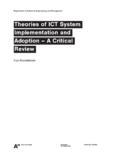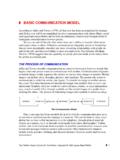Transcription of Communication Theories, Missiology and Music - eltingo.org
1 Communication theories , Missiology and Music By Alan D. Gordon Date: September 26th, 2005 Tutorial: Communication theories Professor: Dr. R. Daniel Shaw Semester: Summer 2005 ii TABLE OF CONTENTS TABLE OF ii TABLE OF FIGURES .. iii INTRODUCTION .. 1 Communication theories .. 2 Code Theory .. 2 Traditional 2 The Role of 5 Relevance Theory .. 7 Cognitive 8 9 10 The Communication 11 Code Theory, Relevance Theory and Music .. 14 Integrating the Two Models .. 16 THE MISSIOLOGICAL 18 Shaw and Van 18 Cross-Cultural 18 God Accommodates to 21 Missiological 23 Shortening the Chain .. 27 Revelation Dynamic .. 27 SOME IMPLICATIONS .. 29 The Purpose of Communication .. 29 Communicating the Gospel Message .. 29 Informing versus Communicating .. 30 Communication AND Music .. 32 Applying Code Theory to Musical 32 Apply Relevance Theory to Musical 33 COMMUNICATING THE GOSPEL THROUGH 35 A Biblical Song .. 35 A Contemporary Song.
2 37 SPIRITUAL Communication .. 40 Karen Kuchan .. 40 Communication Biases .. 42 CONCLUSION AND APPLICATION .. 45 REFERENCES 46 iii TABLE OF FIGURES Figure 1: The Communication model of Shannon and Weaver .. 2 Figure 2: A Basic Communication model .. 3 Figure 3: Hiebert s model of Interaction .. 4 Figure 4: Message without Communication .. 11 Figure 5: Ineffective 12 Figure 6: Effective Communication .. 13 Figure 7: Hill s Quadrant .. 14 Figure 8: Rogers Integration model .. 16 Figure 9: Communication and Cultures .. 19 Figure 10: Accommodation in Relevance Theory .. 20 Figure 11: Accommodating to another culture .. 21 Figure 12: The Missionary as a 24 Figure 13: The Missionary as a Facilitator .. 25 Figure 14: Revelation Dynamic .. 28 Figure 15: King s model of Music 32 Figure 16: The Communication Triad during the Worship Music .. 38 Figure 17: The Data Box Applied to 42 1 INTRODUCTION The purpose of this tutorial is to explore how Communication theory relates to Music .
3 The main question I will be pursuing is: How does Music communicate? First I will discuss code theory, which has been a traditional model for Communication . Then I will examine Communication from the bias of relevance theory, which has been more recently proposed. Once these two biases are defined and explained, I will discuss Communication from a missiological bias. This deals with inter-cultural Communication and the Christian task of relating God s message to others. Finally I will apply these three biases to Music . The result will be a combination of Communication theory, Missiology , and ethnomusicology and how to use this combination to do my research on The Role of Song in Christian Discipleship. 2 Communication theories Code theory and relevance theory have often been viewed as contradictory, but a closer examination will reveal that they are complementary and can be incorporated to form a single Communication model . Code Theory I will first examine some of the models of Communication and then enter into a discussion of the importance of the role of meaning in Communication .
4 Traditional Models Code theory has been the traditional model for studying Communication . Shannon and Weaver are credited with developing the basic model used much even today (Shannon 1949:5). They developed their model from a mathematical perspective applied to the telegraph. Figure 1 illustrates their model . It is interesting to note that their model does not include encoding, nor feedback, which were soon to be added. Figure 1: The Communication model of Shannon and Weaver From Shannon and Weaver, code theory has developed into a generally used model , which may be described as follows. The central idea of code theory is the 3 transmission of a message. The message requires someone to send it, and another person to receive it. The message must be encoded into some symbolic form, whether this be spoken words, electric signals, gestures, or written words. The receiver must then decode the symbols in order to understand the message. The message can be transmitted through various channels, and its transmission can be affected by noise.
5 The basic model is illustrated in Figure 2, and is often represented by the symbols: S-M-R which stand for sender, message, and receiver (Schramm 1963:7); (Nida 1960:47). S e n d e rR e c e i v e rM e s s a g eE n c o d e sD e c o d e sC h a n n e lN o i s eF e e d b a c k Figure 2: A Basic Communication model Others, such as King, have emphasized the aspect of feedback, since the receiver can respond to the message and by sending another to the sender, especially in a musical performance (King 1989:60). Others have proposed that each person is both a sender and receiver simultaneously (Kraft 1978:82), creating a model of interactive Communication (Hiebert 1985:166). See figure 3. 4 Figure 3: Hiebert s model of Interaction And others have detailed the different channels through which the message may be sent. Berlo details five channels, which correspond to the five human senses (Berlo 1960:32), but Smith expands the list to twelve signal systems: verbal, written, numeric, pictorial, audio, artifactual, kinesic, optical, tactile, spatial, temporal, and olfactory (Smith 1992:163).
6 The S-M-R model remains the basis for Communication theory today. It is hard to deny from personal experience that a person says something, someone else hears what is said, and a message has been sent from sender to receiver. But the question is: Is the meaning in the message, in the symbols that are sent? The answer has traditionally been yes. Therefore much effort has been spent on analyzing language and how people use words to communicate with each other. But, this logic breaks down in the following scenario: Mike says to Bill, Are you going tonight? Bill replies, Yes. But Bill thought Mike was referring to a concert, when Mike was thinking about a ball game. Was a message sent and received? Yes. But 5 the received message does not match the sent message. What happened? Sperber contends that the meaning is not in the message (Sperber 1986:23). But he was not the first. The Role of Meaning Many Communication theorists have proposed that in the Communication process the message does not contain the meaning.
7 This is a fundamental shift in Communication theory where it was assumed that the message carried the meaning. But that assumption began to be challenged. Berlo, one of the early Communication theorists, built on the model of Shannon and Weaver, but with a profound difference: meaning is not in the message, but in the person (Berlo 1960:175). When persons share similar meanings they can communicate more easily. What this means is that the same message may not communicate the same thing to two persons. Each will give it their own interpretation and meaning. Kraft follows this same train of thought: Meaning is the creation of the receptor (Kraft 1991:77). This implies that meaning is not even transferred1, but people create meaning themselves. Alaichamy states it well: In human Communication , meaning is not transferred from one end to the other end as in telecommunication. Instead, meaning is created in the minds of the receptors during the process of Communication .
8 Human Communication is a process of meaning creation, not meaning transference (Alaichamy 1997:56). 1 Messages can be transmitted from one person to another, but meanings cannot (Gudykunst 2003:6). 6 This has significant implications for Communication theory, especially for missionaries: The understanding that what messages mean is constructed by the receiver rather than inherent in the message is perhaps the single most threatening insight of contemporary Communication theory for Christian communicators (Kraft 1991:92). And thus Kraft advocates that the communicator must take into account the receptor of the message even more than the message itself. All of these theorists lay the groundwork for the discussion of relevance theory, showing that relevance theory is really not a new idea. I will discuss Sperber in full later, but here are a few previews: Even Donald Smith s description of BITs is very similar to Sperber s information processing.
9 There is no way to transfer meaning directly from teacher to student, from employer to employee, or from preacher to congregation. Meaning is developed indirectly. The person sending a message can only give information BITs, Binary information units. The receiver of a message assembles the BIT of that message into a meaning, using a mental model that seems related to the new message (Smith 1992:64). The idea of assembling the BIT is similar to Sperber s idea of processing evidence using a particular mental context. Another example is Nida s statement: What does S (the source) want R (the receptor) to understand by M (the message)? (Nida 1960:84). This is surprising, because the usual question in Communication had been What does the receptor understand in the message? This sounds a lot like Grice s original idea, from whom Sperber took his initial idea of meaning. I will discuss this in full later, but now I am point out that the key to our discussion on Communication is meaning.
10 But first let us describe briefly Relevance Theory. 7 Relevance Theory One way to simplify the contrast between code theory and relevance theory is that code theory focuses on surface-level Communication , and relevance theory seeks to explain deep-level Communication . This is an over-simplification, but it is useful for beginning the discussion. Another way to see the difference is that code theory comes from a linguistic bias, whereas relevance theory was developed from a psychological bias. The two theories are not mutually exclusive, but complementary. Sperber developed his theory by beginning with an article by Grice which dealt with meaning. Grice s article is based more on logic and philosophy than anthropology or psychology. But Sperber found it useful as a starting point. Grice s main thesis is A meant something by x is (roughly) equivalent to A intended the utterance of x to produce some effect in an audience by means of the recognition of this intention (Grice 1957:385).









